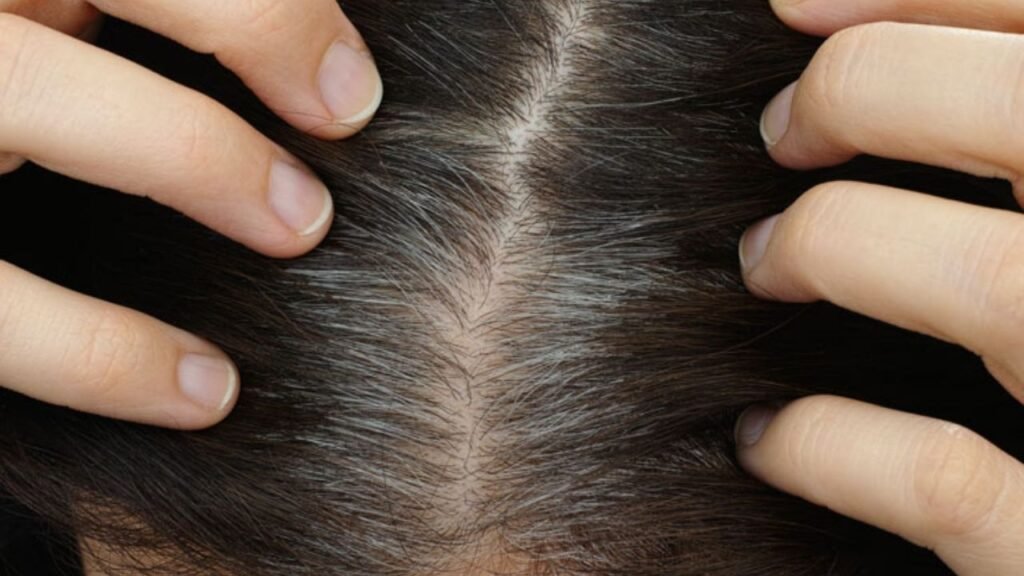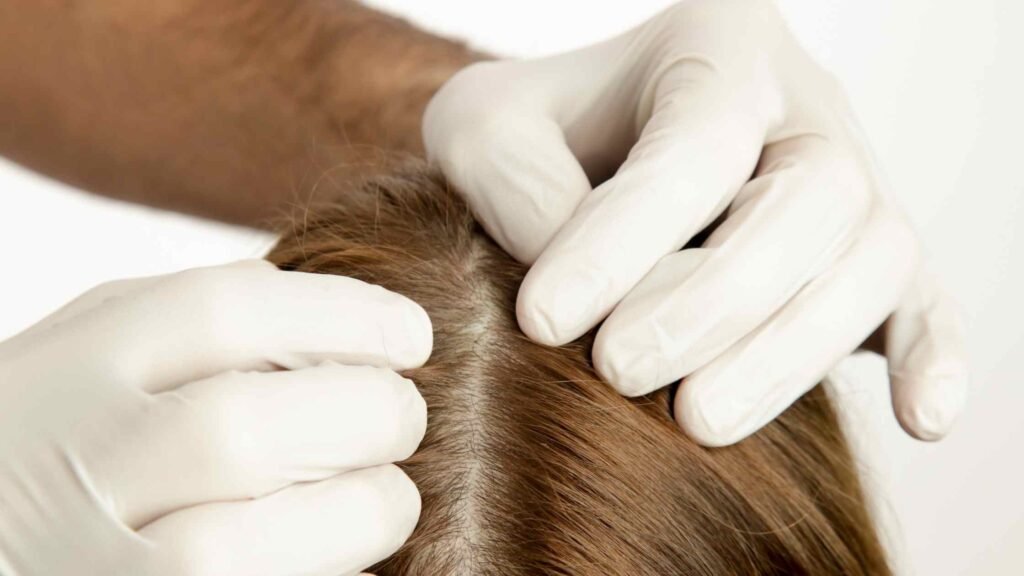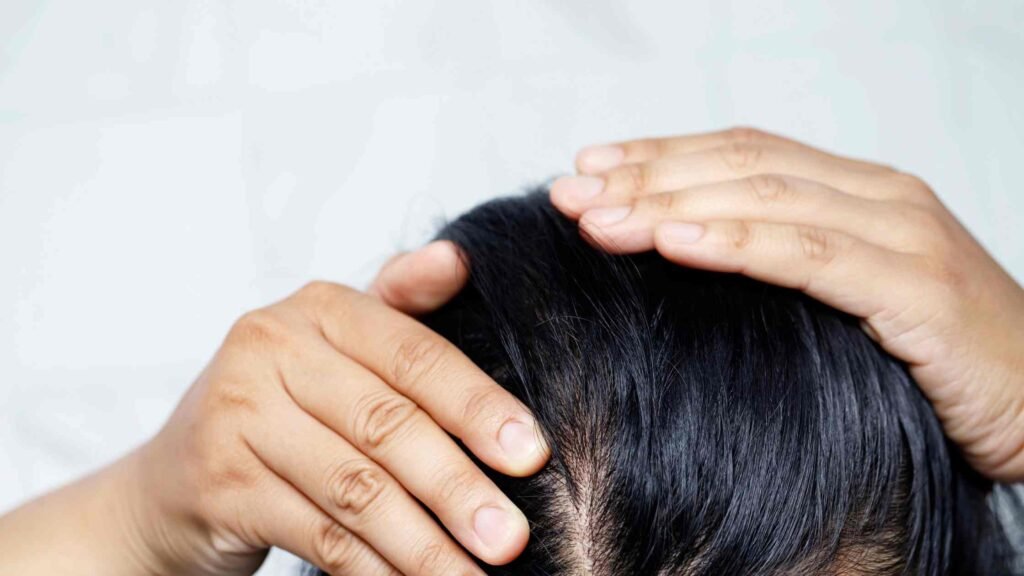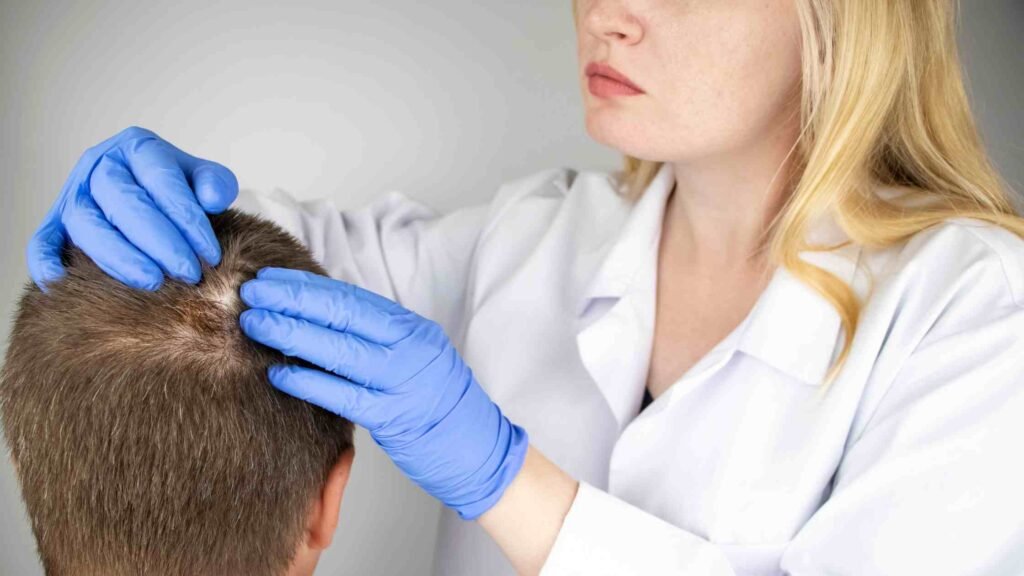Scalp folliculitis is a skin condition in which the hair glands become swollen. It is a pervasive skin disorder commonly triggered by fungous or bacterial infection. At the initial stage, scalp folliculitis may look like white-headed hives or small red bumps around the hair follicles; the infection can spread further and become a severe and nonhealing sore.
Scalp folliculitis is not a life-threatening skin condition, but the patient can experience much discomfort, itchiness, and embarrassment. In many cases, scalp folliculitis has also caused permanent hair loss. But suppose you are diagnosed in the initial stage of this skin condition and have a mild case. In that case, you can expect the condition to be reversed within a few days or weeks with the proper treatment and self-care measures. We always suggest seeing a doctor as soon as possible if you suspect you have visible symptoms to be scalp folliculitis.
Read more about Why Do I Have a Receding Hairline?
This article aims to educate you about scalp folliculitis so that you can take the necessary steps after the problem. The condition is not infectious; therefore, if your family members or friends suffer from scalp folliculitis, you can help them without hesitation or fear of getting affected. Read till the end and know everything you need about scalp folliculitis.

What Is Scalp Folliculitis?
As mentioned earlier, scalp folliculitis is a skin disorder that causes inflammation of the hair follicles on the scalp. In other medical terms, the condition is also addressed as Propionibacterium folliculitis or acne necrotic miliaris. Though scalp folliculitis is characterized by itchy and small eruptions that are troublesome on the frontal hairline, some people can also have a small number of lesions. All the symptoms of scalp folliculitis are hard to leave alone as they are very itchy and crusted.
Read More: How to Stop & Control Hair Fall with PRP Treatment?
What Are The Symptoms Of Scalp Folliculitis?
Scalp folliculitis causes symptoms like red and small bumps on the scalp that looks similar to acne breakouts. Over time those bumps spread to other hair follicles and even get more prominent and inflamed. Scalp folliculitis can occur at any part of your scalp, along with the hairline. The other signs and symptoms of scalp folliculitis are:
- Clusters of red and tiny bumps on the scalp that might have white tips at times
- Sores with pus or yellowish-brown crusts
- Itching and burning sensation
- Tenderness and pain

What Are Different Types Of Folliculitis?
There are two significant types of scalp folliculitis, including deep and superficial. The deep type of folliculitis involves the entire hair follicle and is more severe than superficial folliculitis. The superficial type involves some part of the follicle, not the entire one.
Different types of deep folliculitis are:
Gram Negative Folliculitis– Gram-negative folliculitis may occur if you have been following a prescription for acne for a long time that includes antibiotic therapy.
Sycosis barbae- Generally, males suffer from deep folliculitis in their initial shaving stage.
Boils And Carbuncles– When the hair follicles are severely infected with staph bacteria, boils and carbuncles may occur. Boils are painful pink or red bumps, whereas carbuncle is a cluster of those boils.
Eosinophilic Folliculitis– This type of folliculitis mainly affects people with HIV or AIDS. The symptoms of eosinophilic folliculitis include intense itchiness and recurring bumps and pimples near hair follicles of the upper body and face. Even after healing, the affected skin might look darker than the regular skin color. But the cause of this type of folliculitis is not known.

Different types of superficial folliculitis are:
Bacterial Folliculitis– Bacterial folliculitis is a common type that brings symptoms like white, itchy, and pus-filled bumps. Bacterial folliculitis occurs when your hair follicles are infected with a bacteria named Staphylococcus aureus. These specific bacteria live on our skin but only cause problems when they enter the body through a wound or cut.
Razor Bumps– Razor bumps are skin soreness caused by ingrown hairs. Men with curly hair who shave more than usual notice this type of folliculitis on their faces and neck. Women who get bikini wax may also develop this folliculitis in their groin area. This condition may lead to dark raised scars, commonly known as keloids.
Pseudomonas Folliculitis– The symptoms of this type of folliculitis are itchy, red, and round bumps that occur one or two days later the exposure to the bacteria that causes it. Pseudomonas folliculitis is caused by pseudomonas bacteria commonly found in many places, including heated pools, hot tubs, etc., mainly where the chlorine and pH levels are not regulated properly.
Pityrosporum Folliculitis– This type of folliculitis is the most chronic of all. It shows symptoms like itchy and red pustules on the chest, back, and sometimes on the neck. Many people also notice this type of folliculitis on their upper arms and face. And it is caused by a specific type of yeast infection.

What Are The Most Common Causes Of Scalp Folliculitis?
There are different types of folliculitis, and the reasons behind their occurrence are different too. But commonly, when your hair follicles are damaged by any infection-triggering bacteria and fungi, it leads to folliculitis. The most common causes behind the damage of hair follicles on the scalp include:
- Frequently rubbing or scratching the head
- Twisting or tugging the hair
- Wearing hairstyles that pull the hair too much, such as braids and tight ponytails
- Wearing hats for a long time
- Shaving the head
- Wearing sport helmets
- Building up of hair products due to using too much or not rinsing properly
Many other things increase the risk of developing scalp folliculitis. They are:
- Having dermatitis or acne
- Having curly hair (in men)
- Taking antibiotic therapy or certain medications for acne, including steroid creams
- Having a fragile immune system due to underlying diseases
Read more about Minoxidil Topical Solution For Hair Loss & Its Uses, Side Effects
When You Need To See A Doctor With Scalp Folliculitis?
You already know about the common signs and symptoms of scalp folliculitis. Those signs and symptoms are not going away even after a few days. Though there are many treatments you can prefer at home alongside ways to prevent scalp folliculitis, you need to make an appointment with your doctor if your condition is very severe. Your doctor might suggest you an antifungal or antibiotic medication to control the condition.
Here are some possible complications of scalp folliculitis, and when they occur, you need to see a doctor immediately:
- Recurrence of that spread of the infection
- Boils under the skin
- Scarring and dark spots even after the symptoms are reduced
- Permanent hair loss or damage to hair follicles
How Does The Doctor Diagnose Scalp Folliculitis?
When you see a dermatologist get help for scalp folliculitis, they usually diagnose the condition with the help of physical examination and accessing your past history. They may also ask you to run a few tests to confirm a diagnosis of scalp folliculitis and to rule out other possible conditions. The standard tests might include:
- Gram stain and culture of the pustule content
- Skin biopsy
What Are The Best Possible Treatment Options For Scalp Folliculitis?
If the symptoms of scalp folliculitis on your skin are mild, you can take care of them at home and return to normal again. The most crucial step in treating scalp folliculitis is to stop doing anything that has caused it in the first place. For example, if you have shaved your head frequently, try not to shave further until your follicles clear up for a few weeks. Sometimes you also need to work on your shaving technique.
Try the treatments below to treat scalp folliculitis:
Antibacterial soap: If your scalp folliculitis has affected your hairline, gently wash the skin area twice daily with antibacterial soap and dry the area using a clean towel.
Warm compress: You can apply a warm and damp cloth to soothe your scalp and drain the pus if present. A warm compress will help you reverse the condition within a few days.
Anti-dandruff shampoo: When affected by scalp folliculitis, you need to take good care of your scalp. Wash your scalp with anti-dandruff shampoo that contains antifungal components such as tea tree oil, ketoconazole, and ciclopirox. You can search online shopping sites for anti-dandruff shampoos containing those antifungal agents.
Antibiotic ointment: If you see a doctor for scalp folliculitis, they will suggest some antibiotic ointments like Neosporin to apply to the area to target the bacteria.
Cortisone cream: You can find a cortisone cream in your nearby drugstore or online stores that will help you soothe the inflammation and itch of scalp folliculitis.
Cleaning: Cleaning all the items, including hats, combs, etc., that have come into contact with the infected area of your scalp is necessary to stop the spread of scalp folliculitis further.
Lukewarm water: Avoid washing your scalp with hot water as it can irritate your scalp; therefore, use lukewarm water while washing your hair and scalp.
Oral medications: Not necessarily your dermatologist will prescribe oral medications to treat scalp folliculitis. However, suppose your case is severe, or you encounter a recurring infection. In that case, your doctor might prescribe antibiotics to treat the condition.
Oatmeal: Many home remedies can help reduce scalp folliculitis’s inflammation. Studies suggest oatmeal is a home remedy with anti-inflammatory properties and, therefore, can relieve various skin conditions. Usage of oatmeal for some time can reduce the symptoms of folliculitis.
Oils: There are essential oils, including tea tree oil, lemon oil, eucalyptus oil, and clove oil, with antibacterial and antifungal properties. Therefore, they can be effective in controlling scalp folliculitis. To use those essential oils, mix a few drops with a carrier oil or cream and apply locally to soothe itchiness.
Read more about PRP for Hair Loss: Does it Work, and Is It Safe?
How Long Does It Take To Treat Scalp Folliculitis?
When taken care of properly, your scalp folliculitis will go away within 7 to 10 days. However, in some severe cases, scalp folliculitis causes permanent hair loss or scarring, and the treatment procedure might take longer. But things can become severe without treatment, and the condition might sustain for longer than imaginable.
Severe scalp folliculitis requires medical attention, but if the symptoms are mild, you can treat it with proper care at home and avoid harsh shampoos and cleansing agents that promote aggravation of the condition.
Can You Prevent Scalp Folliculitis?
Now you know how to treat scalp folliculitis, you still don’t expect the condition to occur on your scalp because of the discomfort and pain it brings along. Therefore, you also need to know the preventative measures to keep yourself away from scalp folliculitis. Follow these simple guidelines and prevent scalp folliculitis:
- Use mild soaps
- Don’t scratch your head unnecessarily
- Don’t touch if there is any bump on your scalp
- Avoid shaving your head frequently
- Bathe on a daily basis, especially after workouts
- Don’t tie your hair too tightly
- Don’t use too much oil on your scalp that can clog the follicles and trap the bacteria
- Maintain personal hygiene and do not share your comb and towel with any other person
- Stay away from dirty pools or hot tubs
What Happens When You Leave Scalp Folliculitis Untreated For A Long Time?
If your case is mild, the folliculitis will heal within a few days, even after being left untreated. Pseudomonas or hot tub folliculitis generally takes up to 10 days to heal when left untreated. But suppose your condition is severe and you have folliculitis barbae. In that case, it can gradually spread and progress if left untreated, causing you an infection commonly known as sycosis barbae.
Conclusion:
Scalp folliculitis can be an uncomfortable experience if it becomes too severe or left untreated for a longer time. But if the case is mild, you can manage it at home with proper care. If you are facing specific symptoms like scalp folliculitis but are unsure about your self-diagnosis, it is better to see a doctor. You also need to make an appointment at the earliest if you don’t notice any improvement even after a few days since scalp folliculitis has occurred on your scalp. Your doctor might suggest oral medications, topical creams, and other measures to treat the condition and bring you back to your normal state. Remember that scalp folliculitis is not a life-threatening condition. Therefore there is no need to panic even if it has occurred on your scalp. Believe in your doctor, and you will get back to normal soon. Maintain your hygiene, stay healthy and stay happy.
